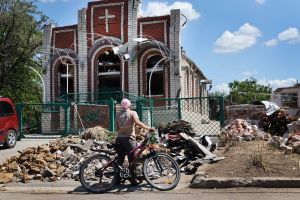Tokyo Electric Power Co. Fails to Plug Radioactive Water Leak
Workers trying to stop radioactive water at the Fukushima Daichi power plant in Japan from leaking into the ocean on Sunday failed in their attempt to use absorbent polymer to plug the crack in a storage bin.
Plant workers packed the polymer along with bags containing sawdust and shredded newspaper into pipes leading to a pit connected to the No. 2 reactor. Experts had hoped the material – also used in baby diapers – would expand to fill the crack. Reportedly, the polymer can soak up to 50 times its volume.
However, the plan did not succeed because the material did not enter the water flow, said a spokesman for the government's Nuclear and Industrial Safety Agency, according to Kyodo News .
Last week, plant workers had found an 8-inch crack in a storage pit behind the plant's No.2 reactor, where the measured level of radiation is the highest.
On Monday, Tokyo Electric Power Co. (TEPCO), owner of the Fukushima Daichi nuclear plant, injected a colored-dye to study the speed and direction of the water flow before resuming efforts to close the gap.
The source of the leak has yet to be found.
The ongoing setbacks in Japan's nuclear crisis reveal the difficulties of stabilizing nuclear fuel rods in order to keep the reactors from overheating at the power plant, which was damaged by a 9.0-magnitude earthquake on March 11. The plant's cooling system was damaged by the earthquake, causing a partial meltdown that released radioactive material into the air, soil and water.
Left with no other alternatives, workers began introducing water to cool the reactors. Although the process seems to have worked, it has created a large buildup of radioactive water that workers need to remove before attaching electric cooling systems to restart the internal cooling process for the plant's three reactors.
Moving water away from the reactors has been difficult because many of the pipes are narrow and cannot pass more liquid. Also, sections of pipes were damaged in the tremor. Because some of the pipes are located in radioactive areas, workers have had difficulties making repairs. Illnesses from radioactive poisoning remain an ever-present danger for plant employees.
Complicating the situation, TEPCO uses three relatively weak pumps to move water. A power plant employee revealed that faster pumps may not solve the problem because the facility's narrow pipes could not handle the increased volume, according to The Wall Street Journal. Officials have not revealed how much water needs to be removed, but Japanese newspaper Asahi Shimbun reported that there is at least 20,000 tons.
More alarming is that the plant is reaching its limit in storage capacity. Water leaving the plant needs to be placed in hard-to-find containers that can handle radioactive substances. TEPCO plans to bring in barges that include the floating fishing pier dubbed "mega-float" from the port city of Shizuoka to facilitate storage.
Since the nuclear disaster began, nearly 78,000 people have fled from the area closest to the disaster zone. Another 62,000 people living within a 12 to 18 miles (20-30 km ) radius have been told to stay indoors. Radioactive particles were reported in spinach and raw milk in nearby prefectures that resulted in a ban on all agricultural products from affected regions.
By Saturday, fears over airborne radiation subsided enough for Japanese Prime Minister Naoto Kan to make an official visit to plant workers and soldiers at the edge of the 12 mile (20 km) evacuation zone.
The Fukushima First Baptist Church, located three miles from the damaged plant, was abandoned after a government evacuation order was given. Its senior pastor, Akira Sato, released a diary that has offered a rare glimpse into the disaster from a Christian perspective.
"Will we ever be able to worship in our church again, or will the town simply be abandoned?" Sato had asked in his March 13 diary entry. "Like the Israelites in the desert, all we can do is follow God as He leads us with pillars of fire and clouds."
While some refugees found shelter with family and friends in other parts of Japan, thousands are still stranded in crowded makeshift emergency shelters. It is unclear when residents from evacuated areas will be allowed to return to their homes.





























